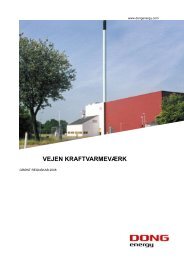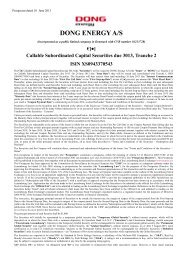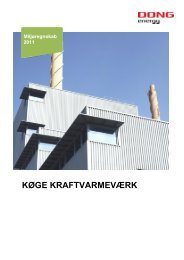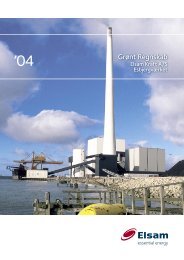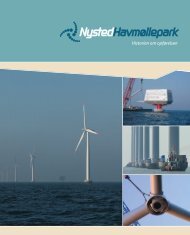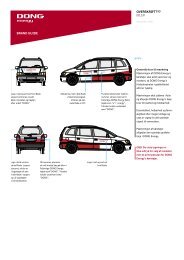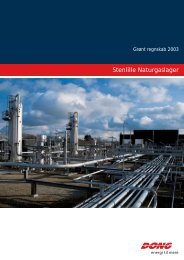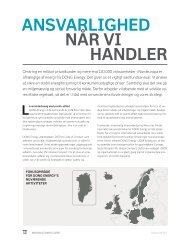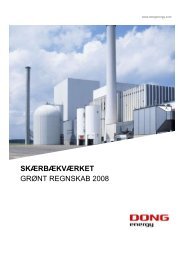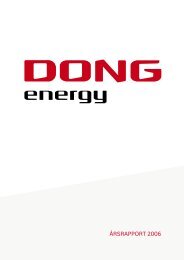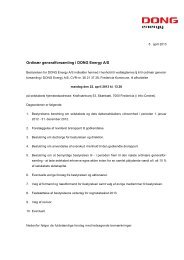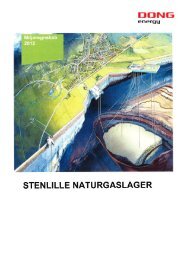ANNUAL REPORT 2011 - DONG Energy
ANNUAL REPORT 2011 - DONG Energy
ANNUAL REPORT 2011 - DONG Energy
Create successful ePaper yourself
Turn your PDF publications into a flip-book with our unique Google optimized e-Paper software.
e<br />
fremog<br />
gas<br />
BusIness AND STRATEGY<br />
By 2020, the target is to halve <strong>DONG</strong> <strong>Energy</strong>’s CO 2 emis-<br />
sions per kWh generated compared with 2006, and CO 2<br />
emissions should be reduced to 100 g/kWh by 2040.<br />
These ambitious targets will be achieved by radical<br />
conversion of <strong>DONG</strong> <strong>Energy</strong>’s electricity generation from<br />
fossil to renewable energy. <strong>DONG</strong> <strong>Energy</strong> continues to develop<br />
offshore wind farms in Denmark, the UK and Germany,<br />
and the plan is for coal-fired power stations to be<br />
converted to biomass. <strong>DONG</strong> <strong>Energy</strong> has also made investments<br />
in power stations that use gas, which emits significantly<br />
less CO than coal. This is the best alternative,<br />
2<br />
among fossil fuels, for safeguarding reliable energy supply.<br />
<strong>DONG</strong> <strong>Energy</strong> operates gas-fired power stations in Denmark,<br />
the UK, Norway and the Netherlands.<br />
The transition to greener energy generation entails<br />
greater technological and geographical diversification. <strong>DONG</strong><br />
<strong>Energy</strong> wants to maintain its position as the market-leading<br />
energy producer in Denmark, while reducing its dependence<br />
on the Danish market by increasing its presence in the markets<br />
in northwestern Europe. In 2006, 91% of the Group’s<br />
electricity generation capacity was located in Denmark. The<br />
Danish proportion was reduced to 67% in <strong>2011</strong> and is expected<br />
to account for just over half of capacity in 2015.<br />
Renewable and thermal energy generation capacity, MW<br />
Coal<br />
7,000<br />
6,000<br />
5,000<br />
4,000<br />
3,000<br />
2,000<br />
1,000<br />
0<br />
Oil<br />
2006<br />
Gas<br />
Robusthed gennem den<br />
integrerede forretningsmodel<br />
Wind and biomass growth<br />
Udvikling af fremtidens<br />
fleksible energisystem<br />
<strong>DONG</strong> <strong>Energy</strong> wants to change the Group via organic growth by means<br />
of investments in green energy from offshore wind farms and conversion of<br />
power stations to biomass<br />
Biomass<br />
<strong>2011</strong><br />
Waste<br />
Wind<br />
2015<br />
estimate<br />
Hydro<br />
10<br />
manaGEmEnt’s rEviEw – <strong>DONG</strong> ENERGY GROUP <strong>ANNUAL</strong> <strong>ANNUAL</strong> <strong>REPORT</strong> <strong>REPORT</strong> <strong>2011</strong> <strong>2011</strong><br />
more renewable energy<br />
Efficient utilisation of <strong>DONG</strong> <strong>Energy</strong>’s unique capabilities<br />
in the area of offshore wind has meant that <strong>DONG</strong> <strong>Energy</strong><br />
is the global market leader in the design, construction and<br />
operation of offshore wind farms.<br />
The electricity generation capacity from wind continues<br />
to rise. Together with electricity generation from power stations<br />
based on biomass and waste, plus hydro power, renewable<br />
energy accounted for 31% of <strong>DONG</strong> <strong>Energy</strong>’s total<br />
electricity generation capacity in <strong>2011</strong>.<br />
The use of coal has been reduced and, compared with<br />
2006, the coal-fired power stations’ proportion of total capacity<br />
for energy production was halved to 24% at the end<br />
of <strong>2011</strong>. <strong>DONG</strong> <strong>Energy</strong> had five coal-fired power station units<br />
fewer than in 2006. At the end of <strong>2011</strong>, gas-fired capacity accounted<br />
for 31% of total electricity generation capacity.<br />
Global market leader in offshore wind farms<br />
The first offshore wind farms in the world were built on<br />
Danish territory. <strong>DONG</strong> <strong>Energy</strong> has since built several Danish<br />
and British offshore wind farms and, in 2013, construction<br />
begins on a German offshore wind farm, Borkum Riffgrund<br />
1.<br />
The first offshore wind farms were established project<br />
by project, but, since the start of 2009, <strong>DONG</strong> <strong>Energy</strong> has<br />
been working intensively to develop and install offshore<br />
wind farms in an assembly line concept and to enhance efficiency<br />
in all stages of the offshore wind farm value chain.<br />
The first step Water was <strong>DONG</strong> <strong>Energy</strong>’s Affaldlarge-scale<br />
contract with<br />
Siemens to buy over 500 offshore<br />
Wind<br />
Biomasse<br />
wind turbines and the<br />
purchase of the installation company A2SEA, which is<br />
Waste<br />
Gas<br />
jointly owned with Siemens. With these and other meas-<br />
Biomass Oile<br />
ures, the farms can be established in a continuous process<br />
with a constant Gas focus on optimum Kul use of skills and resources<br />
and Oil thus maximum value creation at all stages<br />
from design Coal to operation. As the construction cost makes<br />
up three quarters of the total cost in the service life of an



